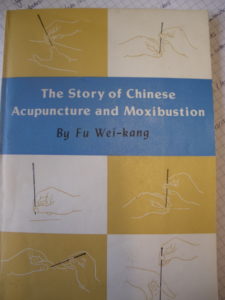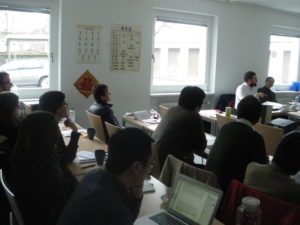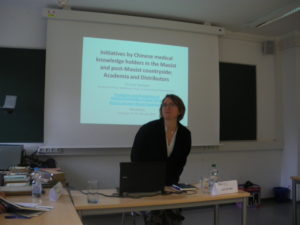Production and Distribution of Medical Knowledge in Rural China: Maoist and post-Maoist Experiences (2014)
Workshop
Erlangen, 11-12 February 2014
 This workshop took place at the Friedrich-Alexander-University Erlangen-Nuremberg in February 2014 and laid the foundation for research projects that address the problem of dissemination of scientific thinking and acting among famers and workers by shedding light on the transformation of medical knowledge (including veterinary medicine) in the Maoist and post-Maoist era. For a recently concluded project see here.
This workshop took place at the Friedrich-Alexander-University Erlangen-Nuremberg in February 2014 and laid the foundation for research projects that address the problem of dissemination of scientific thinking and acting among famers and workers by shedding light on the transformation of medical knowledge (including veterinary medicine) in the Maoist and post-Maoist era. For a recently concluded project see here.
Empiricism and the Nation
Tong Lam, University of Toronto, Canada
The presentation addresses how and why empirical knowledge and the modern fact became the basis for the construction, imagination, and management of the Chinese nation-state. Drawing on arguments from my book A Passion for Facts as well as my ongoing research on contemporary China, this presentation seeks to discuss how empirical facts are used by the state and corporations for governance and by the ordinary people to curate their everyday life, both in the turn of the last century and today.
Promoting Scientific Thinking in Communist China – the conceptualization of medicine in Maoist China
Marc Andre Matten, Friedrich-Alexander-University Erlangen-Nuremberg, Germany
This paper discusses the strategies and methods of propagating science and scientific thinking in post-1949 China. By focusing on the modernization and introduction of new medical knowledge I argue that the dissemination of new knowledge (kexue puji) was a highly complex process that owed its success to a great deal of creativity in defining and legitimizing both modern and traditional, foreign and indigenous forms of scientific knowledge. By analyzing medical handbooks and manuals, journals and textbooks, as well as new media, I show that this resulted in the creation of two different systems of knowledge that both claimed to be scientific, but surprisingly did not contradict each other. Though omnipresent in Maoist China and sometimes serving a purpose in political campaigns, the application of science (kexue) was rather pragmatic.
US Aids and the Distribution of Veterinarian Knowledge in Post-war Taiwan
Che-chia Chang, Institute of Modern History, Academia Sinica, Taiwan
This paper is to discuss the establishment of the modern veterinarian knowledge in Post-war Taiwan. Under the support of the US Aids, the Joint Commission of Rural Reconstruction (Nongfuhui農復會) was set up to play the major functions. In order to strengthen the “Base of Revival”, the Joint Commission greatly relied on the veterinarian knowledge as well as personnel from the United States to promote the new pasturage in Taiwan. This paper would especially focus on the strategy and ideas behind the media, including film and the major journal Fengnian豐 年 (Abundant Year), of broadcasting veterinarian knowledge, so as to unveil the situations and receptions of the post-war rural Taiwan.
Initiatives by Chinese medical knowledge holders in the Maoist and post-Maoist countryside: Academia and Distributors
Lena Springer, King’s College London, United Kingdom
Changes in Chinese medicine during the Maoist and post-Maoist eras need to be assessed in relation to various layers of society and distinctive local regions. Without disputing the real historical cut in medical and cultural history before and after Mao Zedong’s rise in politics, I argue that there is more to medicine during the Maoist period than currently available to us in mainstream official historiography and its propagated global icons. TCM in the hands of peasants, workers and soldiers, and the celebrated barefoot doctor are still powerful myths today that can reshape memories of medical practice. Behind those images, important actors in the medical domain and the roles they played for the production and distribution of knowledge are often concealed by politically sanctioned narratives and by powerful media in popular culture. This paper addresses a different history derived from the personal memories of physicians living through these times: working alone in rural landscapes, then moving into Chinese medical institutions, and then retreating again into private practice. New developments in Chinese medicine happened not only according to government- and party-orchestrated plans, but the social fragmentation and cultural chaos resulting from these campaigns had unexpected outcomes. Local initiatives beyond the reach of central planners by actors in two interlinked but under-researched fields of medical practice in Chinese society were crucial for the continued practice of Chinese medicine. These spaces are first the rural areas of China to which physicians were dispersed during the Maoist period, and second the scholarly spaces of Chinese medicine, beyond the reach of city-made medicine campaigns. While some of these actors later entered Chinese medicine institutions and academia, others still practice “folk” Chinese medicine privately. For all of them, memories of earlier phases in their careers, when they prescribed pharmaceutical products in diverse, often rural, localities, continue to crucially shape their practices.
Based on fieldwork in Yunnan and Sichuan, I will show how the varied experiences of medical knowledge holders in the countryside, their individual initiatives and scholarship reshaped “Maoist” Chinese medicine. Reinventing themselves as post-Maoist businessmen, they still depend on expertise from and about the countryside where the production and distribution of medicines begins. I will introduce their roles in the curious story of TCM-institution-building and distribution of medicines through rural China.
Science for the “New Society:” the Dissemination of Scientific Knowledge in the 1950s and the 1960s
Rui Kunze, Friedrich-Alexander-University Erlangen-Nuremberg, Germany
The fifth part of the Common Program of the People’s Congress (Renmin zhengxie gongtong gangling 人民政协共同纲领, 1949) of the People’s Republic of China (PRC) not just set up the features of culture and education as being national, scientific, and of the masses, but further stipulated that “the love of science” should be promoted as a civic virtue and scientific knowledge should be disseminated. The notion of “science” includes natural science in service to industry, agriculture, and national defense and scientific historical view to study and explain history, economics, politics, culture and international affairs. This presentation intends to give a survey of the implementation of these ideas on “science” in the first two decades of the PRC, which carried both changes and continuities from that of Republican China and laid the foundation of the knowledge production of “science” in the PRC, especially Maoist China. By looking at the following primary sources: pictorials, school textbooks, popular science magazines, professional journals for cadres in the management position, a large part of the presentation will concern itself with the discursive strategies of science dissemination among two groups essential to forming the “new society” – the worker (new class) and the child (new man). These strategies are different yet related to those used for rural audience (e.g. 劳模技术革新表演 technological innovation demonstration of the working model vs. 试验田 experiment field). As examples, I plan to analyze the discursive strategies employed in the introduction of technological innovations, in particular the indigenous ways of smelting iron and making steel, in popular science magazines (e.g. Zhishi jiushi liliang 知识就是力量, Kexue huabao 科学画报) and professional management journals (e.g. Yejinbao 冶金报) as well as science education textbooks for primary schools (ziran 自然 or changshi 常识) from the early 1950s to the mid-1960s.

